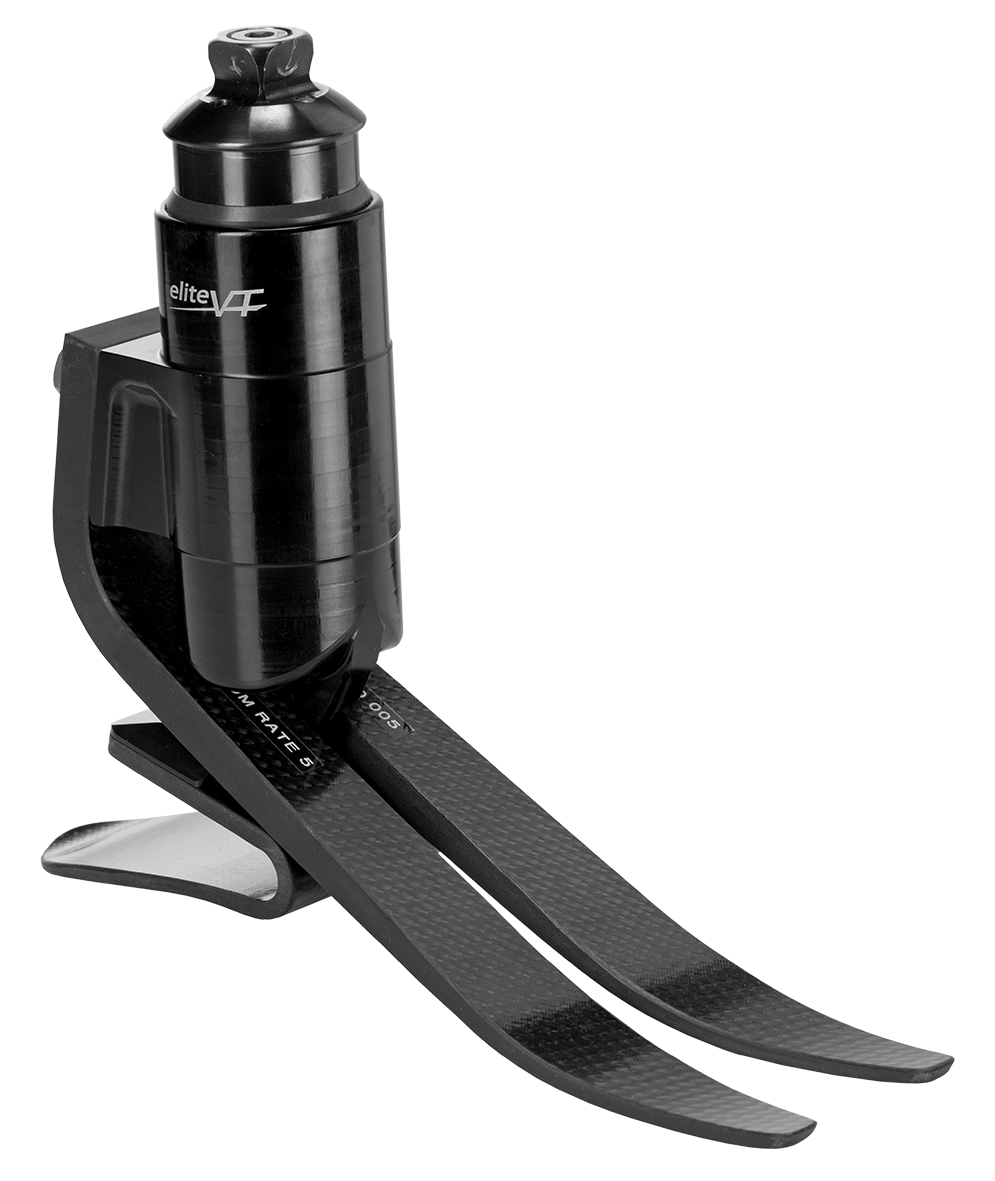EliteVT
The EliteVT prosthetic foot delivers shock absorption, rotation and stability to Level 3-4 users in a cosmetic and compact package. It manages the requirements of both walking and running through balancing biomimetic functionality with our proven spring technology.
- Activity level 3
- Activity level 4
- Suitable for outdoor use
EliteVT Clinical Evidence Reference
Clinical Outcomes using e-carbon feet
-
Safety
- High mean radius of curvature for Esprit-style e-carbon feet2: “The larger the radius of curvature, the more stable is the foot”
-
Mobility
- Allow variable running speeds3
- Increased self-selected walking speed4
- Elite-style e-carbon feet (L code VL5987) or VT units demonstrate the second highest mobility levels, behind only microprocessor feet5
-
Loading symmetry
- Users demonstrate confidence in prosthetic loading during high activity6
- Improved prosthetic push-off work compared to SACH feet7
- Increased prosthetic positive work done4
-
User satisfaction
- High degree of user satisfaction, particularly with high activity users8
Improvements in Clinical Outcomes using shock-absorbing pylon/torque absorber compared to rigid pylon
-
Safety
- Reduced back pain during twisting movements e.g. golf swings9
-
Mobility
- Reduced compensatory knee flexion at loading response10
- No reduction in step activity11
- Blatchford torsion adaptors match the able-bodied rotational range12
-
Residual Limb Health
- Reduced loading rate on prosthetic limb13, particularly at fast walking speeds14
- Users feel less pressure on their residual limb15
-
User Satisfaction
- Patient preference, citing improved comfort, smoothness of gait and easier stairs descent13
References
-
Full Reference Listing
-
Crimin A, McGarry A, Harris EJ, et al.
The effect that energy storage and return feet have on the propulsion of the body: A pilot study. Proc Inst Mech Eng [H] 2014; 228: 908–915.
-
Curtze C, Hof AL, van Keeken HG, et al.
Comparative roll-over analysis of prosthetic feet. J Biomech 2009; 42: 1746–1753.
-
Strike SC, Arcone D, Orendurff M.
Running at submaximal speeds, the role of the intact and prosthetic limbs for trans-tibial amputees. Gait Posture 2018; 62: 327–332.
-
Ray SF, Wurdeman SR, Takahashi KZ.
Prosthetic energy return during walking increases after 3 weeks of adaptation to a new device. J Neuroengineering Rehabil 2018; 15: 6.
-
Wurdeman SR, Stevens PM, Campbell JH.
Mobility analysis of AmpuTees (MAAT 5): Impact of five common prosthetic ankle-foot categories for individuals with diabetic/dysvascular amputation. J Rehabil Assist Technol Eng 2019; 6: 2055668318820784.
-
Haber CK, Ritchie LJ, Strike SC.
Dynamic elastic response prostheses alter approach angles and ground reaction forces but not leg stiffness during a start-stop task. Hum Mov Sci 2018; 58: 337–346.
-
Rock CG, Wurdeman SR, Stergiou N, Takahashi KZ.
Stride-to-stride fluctuations in transtibial amputees are not affected by changes in push-off mechanics from using different prostheses. PloS one. 2018;13(10).
-
Highsmith MJ, Kahle JT, Miro RM, et al.
Differences in Military Obstacle Course Performance Between Three Energy-Storing and Shock-Adapting Prosthetic Feet in High-Functioning Transtibial Amputees: A Double-Blind, Randomized Control Trial. Mil Med 2016; 181: 45–54.
-
Rogers JP, Strike SC, Wallace ES.
The effect of prosthetic torsional stiffness on the golf swing kinematics of a left and a right-sided trans-tibial amputee. Prosthet Orthot Int 2004; 28: 121–131.
-
Berge JS, Czerniecki JM, Klute GK.
Efficacy of shock-absorbing versus rigid pylons for impact reduction in transtibial amputees based on laboratory, field, and outcome metrics. J Rehabil Res Dev 2005; 42: 795.
-
Klute GK, Berge JS, Orendurff MS, et al.
Prosthetic intervention effects on activity of lower-extremity amputees. Arch Phys Med Rehabil 2006; 87: 717–722.
-
Flick KC, Orendurff MS, Berge JS, et al.
Comparison of human turning gait with the mechanical performance of lower limb prosthetic transverse rotation adapters. Prosthet Orthot Int 2005; 29: 73–81.
-
Gard SA, Konz RJ.
The effect of a shock-absorbing pylon on the gait of persons with unilateral transtibial amputation. J Rehabil Res Dev 2003; 40: 109–124.
-
Boutwell E, Stine R, Gard S.
Shock absorption during transtibial amputee gait: Does longitudinal prosthetic stiffness play a role? Prosthet Orthot Int 2017; 41: 178–185.
-
Adderson JA, Parker KE, Macleod DA, et al.
Effect of a shock-absorbing pylon on transmission of heel strike forces during the gait of people with unilateral trans-tibial amputations: a pilot study. Prosthet Orthot Int 2007; 31: 384–393.
-
EliteVT Documentation
-
Product Information
-
EliteVT Brochure
-
-
Other downloads
-
Blatchford Product L Codes January 2024
-


